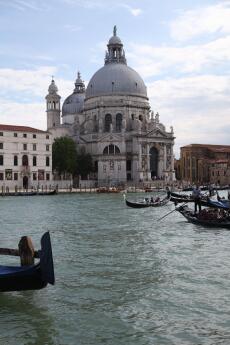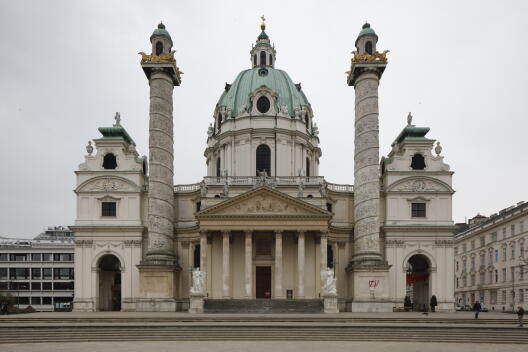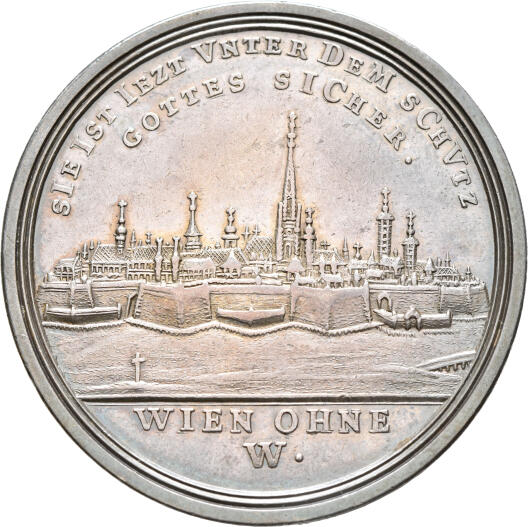Staging the end of the plague in the early modern period: Venice 1631, and Vienna 1714
By art historian Jens Niebaum
The Covid pandemic has more or less petered out in Germany. Measures have gradually been scaled back or lifted altogether; most striking perhaps is that the obligatory wearing of a mask ended earlier here, later there, and apparently not at all elsewhere. The WHO’s declaration of the end of the pandemic on 5 May 2023 was more a bureaucratic act and had little significance for people. There were no celebrations to mark the end of the period that had brought great suffering for many, and more or less drastic restrictions for all. This was perhaps in line with our scientific or medical view of things: we know that Covid has not “gone”, but has simply passed (to use our recently acquired medical-bureaucratic jargon) from an epidemic to an endemic state. Moreover, even before this transition, the great success of the vaccination campaign had reduced much of the virus’ terror. Before anything like the end of the epidemic could be proclaimed, life had largely returned to normal, at least in the West.
In the early modern period, epidemics usually ended differently. Where an epidemic was primarily understood or at least communicated as God’s punishment for people’s sins, the before and the after were usually more sharply defined. While the epidemic was rampant, people, besides observing a catalogue of medical and hygienic measures that not only became more extensive and detailed over time, but also varied from place to place and from country to country, had to pray to God that he protect them from the epidemic and to give thanks if this proved the case. Religious services and such celebrations signalled and staged the end of suffering, which the overwhelming majority saw as a result of appeasing God’s wrath. Wherever rulers, communities, groups, or individuals had pledged themselves to God or his saints if they were spared from the plague and death, the beginning of a new period that people hoped would be free of the plague forever was marked by the fulfilment of this vow.

“Per publico beneficio, et à consolatione universale ... publicar libera dà contaggio la sudetta città”[1]
On 21 November 1631, Venice was declared free of the plague “per gratia del Signor Dio et intercessione della B. Vergine Santa Maria della Salute”, this announcement being celebrated with a great festival. It followed one of the most devastating plagues in the history of the Serenissima, which had claimed the lives of almost 46,500 people in the city alone between July 1630 and October 1631. The official account of the festival reports that the announcement made by the Magistrato della Sanità, the Venetian health authority, took place on the piazza in front of the San Marco church, and that the piazza was lavishly decked out with temporary structures, rugs and paintings. Immediately after the announcement, kettledrums and trumpets sounded, guns were fired, and bells rung. The Doge, the Signoria, the Senate, and other officials and dignitaries went to St Mark’s to attend the high mass held there by the primicerio Marcantonio Cornaro, head of the chapter of the basilica. On the high altar was the icon of the Madonna Nicopeia, the victorious Mary who had grown into the role of Palladium of the Republic, painted, according to legend, by the evangelist Luke. Music by Claudio Monteverdi, the chapel master of San Marco, was heard. Then, led by the Nicopeia, a great procession set off comprising the members of the six great brotherhoods (“Scuole Grandi”), the religious orders, the Doge, the Senators, and many others.
As with ceremonial processions in honour of rulers, this procession passed through six ephemeral arches of honour and over a pontoon bridge, and had as its destination a small wooden church near the Dogana on the headland between Canale della Giudecca and Canal Grande. Erected in just four days, this church was decorated with rugs and lit up with numerous lights. The famous votive church of Santa Maria della Salute, St Mary of Health, would be built here in the decades to come. As a means to appease God’s wrath, the Doge had solemnly promised to build the church by resolution of the Senate of the Republic on 22 October 1630, at the height of the plague. This act explicitly invoked the positive experiences of vows and the construction of the Redentore Church during the terrible plague of 1576-77.
Unlike in many other cases, however, fulfilling this vow did not coincide with the end of the epidemic, but was set in motion with the appointment of a team of administrators, the selection of a possible site, and the announcement of a competition among architects. The laying of the foundation stone on 1 April 1631 also took place while the epidemic was still raging. God’s grace would be gained not only through a vow, but also through the actual building of the church, which, as already stated in the vote of 22 October, would be “Magnifica, et con pompa della devotione nostra”. Built according to the designs of the still young architect Baldassare Longhena and only consecrated in 1687, it is one of the most magnificent churches ever built in Venice. In accordance with the wording of the vow, the procession from the San Marco to Santa Maria della Salute was to be repeated every year. The end of the plague, the averting of the plague through the intercession of Our Lady, became an integral part of the collective and ritual memory of the Republic both in the magnificent church building and in the annual procession.

“Wien ohne W” (“Vienna without V”)
When Vienna, the Emperor’s residential city, was hit – for the last time – by a plague in 1713, the reigning monarch Charles VI also took refuge in the vow to construct a church. On 22 October, when the plague had been raging for half a year, he held a procession from the court parish church of St Augustine to St Stephen’s Cathedral. Here, he solemnly vowed for himself, his house, his kingdoms, and provinces (“pro Me, Domo, Regnis, ac Provinciis meis”) to build a church under the title of Saint Charles Borromeo, where masses would be celebrated every day in perpetuity, and the Rosary and the Litany of Laureto recited in order to keep the plague from the Austrian lands. With the holy Archbishop of Milan, the Emperor had chosen as the patron saint of the new church not only his own patron saint, but also one of the most prominent plague saints.
With the onset of the cold season, the number of plague cases did indeed fall noticeably, and there was a gradual return to “normal” life: the first half of January saw the city’s schools reopen, the courts reconvene, and the Lower Austrian government meet for its first session. Between the end of December 1713 and the end of February 1714, the three military hospitals could be closed one after the other. Houses and flats that had been locked up and marked with a cross were opened and cleaned. Gambling also resumed, only for the Emperor to forbid the practice in the strongest terms on 21 February: because of the curses that it gave rise to and the danger of ruin that it posed to entire families, gambling was deemed a particularly strong trigger of God’s wrath. Finally, on 15 March 1714, an imperial commission announced the end of the epidemic throughout the country.
Two days earlier, a great thanksgiving festival had been celebrated “on account of the relief of this imperial residence from the contagious epidemic” (according to the chronicler Matthias Fuhrmann). Once again, a procession comprising among others the imperial couple, the city clergy, the guilds, the estates, the imperial chamberlains, and the privy councillors marched to St Stephen’s in the presence of a Charles Borromeo relic. The Jesuit and court preacher Franz Xaver Brean gave a sermon of thanksgiving. Its theme was the end of the plague in David’s time according to 2 Samuel 24:25, which tells how God, angered by the king’s arrogance, punished the people of Israel with a plague, and then ordered David to build an altar when the plague was over – on the site where his son Solomon would one day build a temple. For all the differences that Brean points out (Vienna had suffered far fewer victims, and, unlike David, the Emperor was of course entirely blameless for the plague), the parallel is obvious with regard to the atonement vowed.
Unlike in Venice in 1631, however, the construction of the promised Karlskirche had not yet begun, and nor had it even been set in motion. Rather, there was a wait until the plague had really subsided. The planning that followed dragged on for some time: at least three architects submitted designs, one of which has been preserved and is dated 15 April 1714. If, as seems likely, this is the date of completion, then the redemption of the vow would have been set in motion very quickly. However, Charles VI did not make his final decision in favour of a project by the imperial “chief building inspector” Johann Bernhard Fischer von Erlach until the autumn of 1715, and the location of the church near the imperial summer residence Favorita in what is now Vienna’s fourth district was apparently not decided until early September. The foundation stone was laid for the magnificent votive church on 4 February 1716, almost two years after the “official” end of the plague, and building continued until 1737.

Building the Karlskirche kept alive the memory of the victims of the plague and the circumstances in which the plague was extinguished. With the liturgical acts and prayers that it held, the church also asked to be spared any renewed outbreaks in the future. A similar function was assigned to the medal that was minted to mark the end of the epidemic. One side shows a view of the city from the south-east with the high tower of St Stephen’s slightly to the right of centre and the legend (with chronogram 1714): “Wien ohne W[eh]. / It is now safe under the protection of God”. On the other side, below the tetragram in glory and surrounded by two laurel branches tied together, is the legend: “God did not leave the Emperor, as he did not leave his own. The plague subsided in Vienna, the best will soon appear”. This alludes to the fact that the Emperor did not leave Vienna when the plague broke out, but remained in the city; this is paralleled typologically with the action of God, which resulted in the end of the plague. The “best” alluded to probably expresses the hope of the birth of the longed-for heir to the throne. The overcoming of the plague, the end of divine punishment, gives rise to the confidence that God will soon also help overcome the dynastic crisis of the royal house. This hope would prove deceptive, however.
[1] “Announce for the public good and general consolation ... that the said city has been freed from the plague” (Ruling of the Senate of Venice, 13 November 1631).

